[Editor's note: I know, I know. This article isn't strictly about sewing. But it's about a topic that relates to fashion and that interests me, so I thought it might interest you too. I hope you'll like it. Mayra]
The History Of Sandals
Sandals are a simple open-toed foot covering that has been a part of almost every culture in the world. They are the simplest form of shoe, with the longest history – from Neolithic cavemen to ancient Rome, to feudal Japan, to the modern tourist. The history of sandals features sandal-wearing men and women in some of the most legendary events of history: the conquests of Alexander the Great and Julius Caesar, the birth of philosophy in Athens, the Muslim conquests, the trials of the biblical Hebrews, to name but a few.
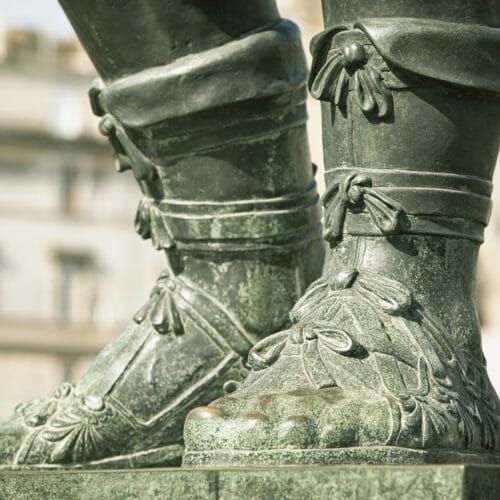
From: https://www.alamy.com/stock-photo/roman-sandals.html
Pre History
The oldest known piece of footwear is a sandal dating back about 10,900 years from the present. It was found on a site in the modern U.S. state of Oregon. The sandal was made of woven sagebrush bark. It is widely believed that sandals were developed independently across many pre-historic cultures at around the same time.
Most of the European, Levant, East Asian, and Native American peoples are found to have possessed footwear in the late Neolithic era. However, due to the organic nature of the materials, mainly being plant matter and leather, archeological evidence is relatively sparse. One exception to this is ancient Egypt, as the tombs of the great Pharaohs contained many well preserved and decorated examples.
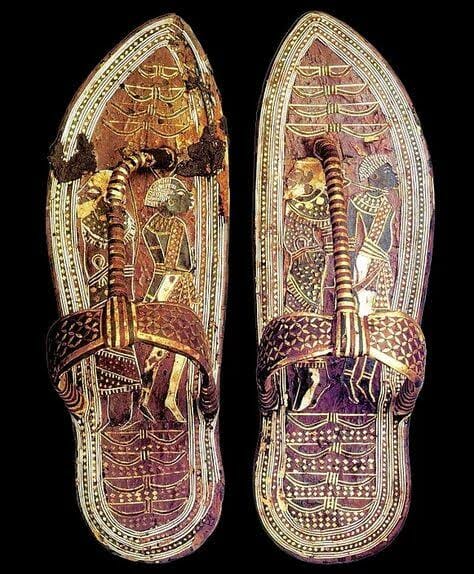

From: https://archaeology-world.com/a-pair-of-golden-sandals-found-in-king-tutankhamuns-tomb-that-shows-how-egyptian-sandals-were-made/
The Ancient World
The ancient world of the great Mediterranean empires was quite fond of the sandal. The hot and dry climates of Spain, Italy, Greece, and the Near East were perfect for the breathable shoes. Though closed-toe shoes were known to most of the ancient peoples, in general, they must have been either too expensive, uncomfortable, or unfashionable (probably all three) for we have very few examples of them in their art or tombs.
One of the most well-known examples of the time period is the classic roman sandal. The military version, called the Caligae is the most iconic, with its metal tacks pounded into the soles for grip and stability.
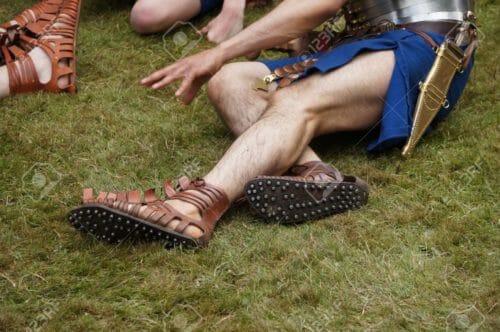

From: https://www.123rf.com/photo_98877214_close-up-of-a-roman-soldiers-leather-sandals-showing-the-metal-hobnails-in-the-sole-.html
A strange-looking, but widespread sandal of the era, is the Assyrian upturned toe sandal. The curved front supposedly is to help walking, perhaps on sandy terrain.
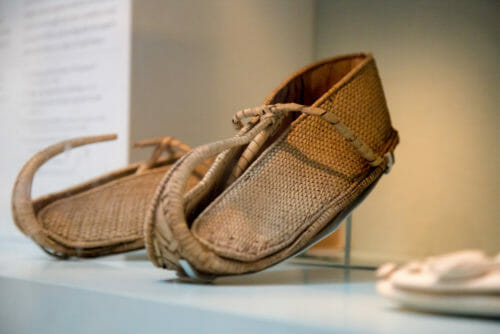

The ancient Greeks preferred a variety of sandals types, usually denoting your rank or profession. Like most fashion, the more ornate or complicated usually accompanied a higher station. Notably, the Greeks are one of the first to add platforms to the sole — usually intended to enhance the wearer's stature or to reflect rank.


From: https://www.pinterest.at/pin/574420127469909601/
Sandals of the ancient world were practically ubiquitous, especially among the poorer classes. There were few that could even afford a simple sandal of tough leather. We can assume that the majority had to content themselves with simple woven sandals of whatever local material they could find.
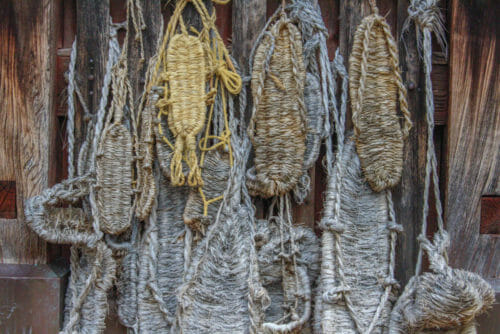

The Middle Ages
In the western world, the middle ages saw a comparative decline in the use of sandals. This is due to a number of factors. In the military, the boot or closed-toe shoe grew in use. Particularly among the powerful western and northern European kingdoms where the weather was generally wetter and colder. The techniques and tools of shoemaking had advanced enough that cobblers could meet the growing demand. The nobility adopted the closed-toe shoes on mass, partially due to the influence of Christianity in prizing modesty.
However, do keep in mind that this change mainly affected the nobility and the military. The peasantry continued to wear what they could provide for themselves, whether that be simple leather boots or traditional grass sandals.
One interesting development of this era is the Patten shoe. Essentially it is a protective sandal worn over a woman's shoe to protect them from the mud and filth of the unpaved roads. They were worn all the way up to the 20th century.


Jean-Etienne Liotard – A Lady in Turkish Dress and Her Servant
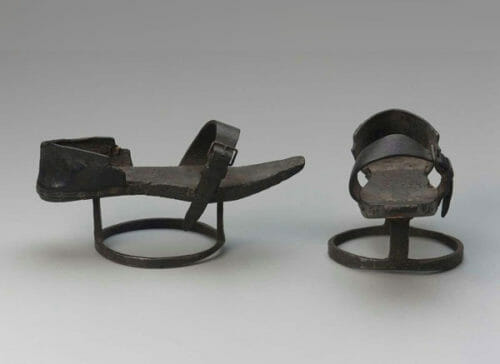

From: https://2communicateblog.wordpress.com/2012/03/07/shoes-glorious-shoes-springsummer-2012/
One might think that the use of the sandal has only been limited to places with warm weather. Surprisingly this is not so. Geta, a wooden-soled sandal from Japan, are worn with fabric socks called tabi that keep out wetness and winter's chill. Similarly, the native people of Eastern Siberia and Alaska wear fur boots that originated as sandals tied over fur stockings. At some time in history, the fur stockings were sewn to the soles, creating a boot, but the sandals' straps remained, sewn into the sole seam, and tied around the ankle.
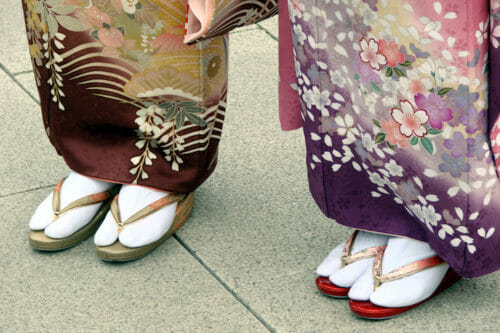

From: https://jpninfo.com/7967
The Modern Era
After World War II the sandal has seen a remarkable comeback. This is mainly due to the loosening of dress practices that previously discouraged exposing the feet and toes. Nowadays go to any warm-weather tourist spot and you'll see the majority of people wearing some sort of sandal.
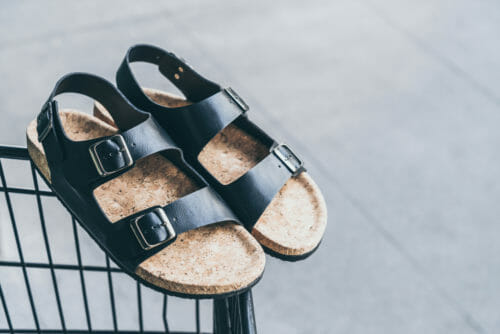

From Asia to the Americas, the simple rubber and plastic flip-flop or thong-style sandal is by far the most common in the world. These are a mainstay of shoe manufacturers in Asia, benefiting from the abundance of labor, rubber, and cheap oil.
Another common style is the resurgent Roman sandal. These vary from the simple mass-produced pairs to the handcrafted made with the softest of leathers. Another return from the past is the raised platform sandals.
If you are really interested in a detailed history of sandals I recommend this blog dedicated to the subject: historyofsandals.blogspot.com
I hope you enjoyed this quick history of sandals. See you next time with another history of… (please leave your suggestions in the comments below.)
If you like the “history of” articles, please check out The Short History of Polyester Fabric.








What a nice change of pace to read an article about fashion without having to sew it. It is not that I am tired of sewing, I am just tired of sheltering in place and want to wear my sandals to the beach and breathe air without a mask. Oooh, sorry, just got a little crazy there for a moment. LOL
Actually, this was a very interesting article. I loved the pictures of the different types of sandals. I wonder if the Turkish ladies had a lot of broken ankles and legs from wearing those precarious looking sandals. I could just see one of those sandals getting stuck in the mud and the lady doing a head over heels somersault. Ouch!
very cool
Thank you for the interesting article. I like to know the beginnings of our clothing cultures of dress and design.
Loved the article! The most interesting to me was the photo of King Tutankhamuns’ sandals. Other than the extreme decoration they look much like many sandals of today. (And I think I like all that decoration!)
I loved the sandal history, very interesting
Great article. Really interesting. Thank you.
This is an interesting article. From the picture of a lady in Turkish dress wearing pattens, I see that the the practice of wearing what was stylish rather than practical is nothing new — talk about a balancing art! Someday a history of seams would be of interest.
Very interesting. Thank you for the insight into the sandal. I thoroughly enjoyed reading it.
Thank you for the wonderful article! I love history and history of fashion is always interesting!
Thank you Mayra! So interesting and I’m so glad you shared with us fashionistas:) . That curved toe looks cool but uncomfortable!
Thanks for sharing the article, which I really enjoyed. I was lucky enough to be in Melbourne and Sydney in February (being the Aussie summer it was stonkingly hot) and was surprised to notice that people didn’t wear sandals in the cities as much as I expected. I thought they’d be universally worn, but the majority of people were wearing flat shoes or trainers with or without socks. Hardly a flipflop in sight.
Enjoyed the history of sandals
Please, share more articles like this. I Enjoyed read it.????????
I like historical remarks on things and found this one very interesting. Thank you for sharing.
Interesting, thanks.
Sandals are my go to footwear through the summer months/ warm weather.
I really liked the article. Admittedly, I have never really given any thought to the history of sandals because I’ve always taken them for granted. When something is everywhere, it’s at its most unnoticeable The article was informative and interesting. Could you do one on the history of high heels or corsets please? I would love to know more about each of them.
Fascinating! Thanks for such a detailed article. I really enjoyed it.